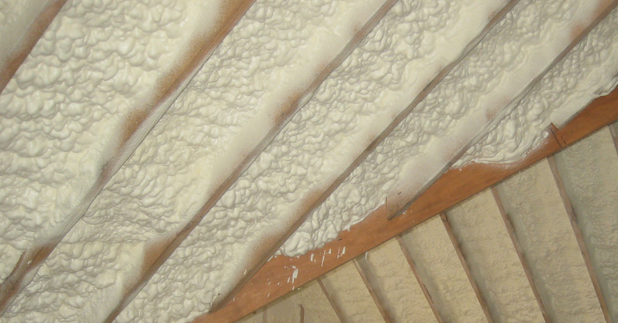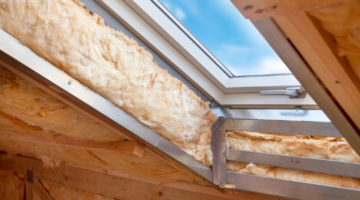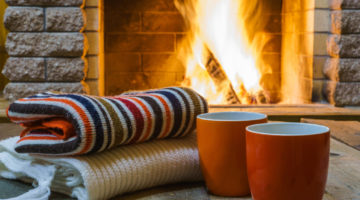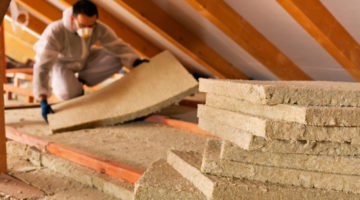
What is spray foam insulation?
Spray foam insulation is a type of insulation that can be used in the roof space at either the joist or rafter level, to help keep warm air in the home during the winter and also prevent the home getting too warm in the summer.
Typically, the spray foam is made up of polyurethane. It is sprayed as a liquid, which then gradually expands to up to 100 times its original volume, and once set it not only creates an effective insulating layer, it also acts to reduce noise pollution.
Can I install spray foam myself?
Spray foam insulation ideally needs to be installed by a professional, since it gives off dangerous fumes and also can actually damage the structural integrity of the building if applied incorrectly.
The reason for this is that the expanding foam can exert some serious pressure on the home’s structure if applied incorrectly and ceilings and walls have been known to collapse or be damaged from DIY installs.
What is open cell and closed cell spray foam?
Foam structures consist of a flexible material that is filled with bubbles of gas (or just air). There are two main types of spray foam, closed cell and open cell.
In closed cell foams, the bubbles are encompassed entirely in the liquid. When the foam sets, each bubble forms a trapped discrete pocket of gas. In an open cell foam, the bubbles all merge with one another, so a gas can travel through the foam (imagine a bathroom sponge).
This gives the two different types of foams different properties.
Features of closed cell spray foam
This spray foam sets rock hard – it is not compressible when it has set, this means that it can help support the structure of the property. However if installed incorrectly it can exert unnecessary strain on the structure of the home. This type of foam will also tend to be much denser as a result and this also means it will be heavier.

The typical U-value for closed cell spray foam is about 0.16 W/m2K
The final thing about closed cell spray foam is that it will not allow moisture across it, which means that you will need to consider ventilation in the loft space to prevent build up of condensation.
Features of open cell spray foam
Open cell spray foam is less dense than close cell spray foam, so it will not help strengthen the structure of the building. In addition, its chemical makeup means that it doesn’t offer the same level of insulating effectiveness as the closed cell. However on the plus side it has high vapour permeability allowing it to breath far better than the closed cell spray, so condensation build-up should be less of an issue. The other major benefit is that it offers better acoustic insulation, absorbing more sound in normal noise frequency ranges.
The typical U-value of open cell spray foam is about 0.35 W/m2K
Since spray foam has better insulating properties than wool (when the same thickness is used), you can achieve the same U-value by insulating to a greater depth. This means that if space is an issue (remember you need to install 270mm of wool insulation to meet building regulations now), then spray foam could be the answer. Typically you will require a depth of 150mm to achieve a u-value of 0.16 W/m2K, but a depth of just 40mm will help you to achieve a u-value of 0.40 W/m2K.
What should I expect to pay for spray foam insulation?
Spray foam insulation is not cheap – while using mineral insulation might cost £6-7 per m2 to achieve a u-value of 0.16 W/m2K, spray foam might cost £45 per m2 to achieve the same value.

Are there any issues with insulating my loft with spray foam?
So having mentioned all the positives relating to spray foam insulation, we feel there is one fundamental issue with using this product to insulate the loft space that we should draw your attention to – and that is ventilation.
If the spray foam is applied to the undersides of roof slates or tiles, it is not possible to keep this ventilation gap, since the foam encapsulates the roofing battens and the top of the rafters, trapping moisture. As you can read here, we think it is really important that you leave a ventilated gap between any insulation and the tiles in order to vent away any moisture otherwise the wood can’t breathe and it will consequently begin to rot. A new roof is not a cheap thing to install!
That being said, if the wooden rafters are treated properly first and it is installed correctly, it is certainly worth considering, although if you want a more sustainable product to insulate with (remember polyurethane is derived from crude oil) then take a look here!













ROOFS INSULATED WITH FOAM FAIL – when you wish to move on and sell your house the new buyers Building Society Surveyors report and roof condition requirements. So when you place your house on the market @ £195k or nearest offer and find a buyer he soon drops out when he’s told the house needs a complete new roof, and the report highlights the bodged spray foam job as the reason why. Many buyers bounce back with an reduced offer, they want £10 000 discount of the price, or else.
A majority of spray foams staff spray the foam all over the place, then they tidy the job up afterwards by trimming off the excess foam globules using an electric foam knife, or an hedge cutter. My advice is too never buy a house with foam in the loft, and keep well away. Google Spray foam electric cutters, or Surveyors view on foam insulation. Caveat Emptor applies, and you cannot sue for damages.
Open cell Icynene has global presence in 30 countries including 16 countries in Europe and is the insulation of choice for a lot of major new builds. Icynene is backed by the BBA. New technology is often met with fear but this product will be the only insulation to be used in future years.
U can have all the accreditation’s u like but I know first hand it’s a problem. April 2021 – I have been informed big lenders in Scotland have been updated not to approve mortgages if foam, any type is used. I now need to look at removal and feel I’ve wasted my money
It’s NOT airtight. It doesn’t work any better that other forms of insulation. This is from someone who has actually had it installed.
Just had icynene spray foam installed under suspended floor by a qualified installer. It has made absolutely no difference. Still cold floors, still the feeling of cold air rushing around at floor level, still air infiltration at skirting boards and gaps in floorboards; I had to get the silicone gun out again and start filling in the gaps. Save your money, it doesn’t really work. The only thing that works is not building crap houses in the first place.
I agree Rose, one room worked for me after I complained and second room didn’t and is just as cold, waste of money
I agree Rose, one room pelted for me after I complained and second room didn’t and is just as cold, waste of money
Martin Hancox is trying to win the debate by not answering or pointing out Spray Foam obvious drawbacks. Readers need only Google “Spray Foam Makes House Unliveable”, to learn the truth, or for actual photos go on Google Images and search for Spray Foam Botched Jobs. On the web there’s one guy stating the foam he got was only 1/4 – 1/2 inch thick in parts, when he complained he was informed “it was a new guys first job and they would come back and rectify it”. They didn’t. The real beef is the prices charged, I’ve heard of £3500.00 for a small semi-detached house being common, the public need to know that it costs £4000.00 to re-roof and re-tile it completely with all new tiles, In my local papers jobs were being offered to sell Spray Foam, average commission stated was £750.00 per deal. It ended you can earn over £100k per year with us. Foam is not a new product, it was outlawed in the UK for Cavity Walls about 25 years ago, and the bad Press Reports crippled this W C Fields – there’s a mug born every minute – business.
Any jobs going?
Spray foam is getting more and more popular in the UK, it’s a great way to insulate your loft and protect for years to come.
Many listed buildings are using spray foam loft insulation, and more and more in commercial use.
I just want to reply to earlier comments.
Regarding the cost of Spray Foam Insulation, there are many re-sellers of spray foam, as there are with many other products e.g. lead agencies who will charge way above the RRP to make a profit for themselves. You would be advised to go directly to the company who manufacture or install the product for a fair price!
Also, there are two different types of spray foam, One is “closed cell” (waterproof) foam for use in roof repair or foundations or walls, When installed as a roof repair system, it is usually for roofs as a last resort before replacement and will add 10-30 years to a roof, depending on the condition of the roof. It is sprayed directly to the underside of the roof tile/slate, As a roof repair system it is used to hold the tiles/slate in place, prevent water ingress and to provide insulation against heat loss. This product has seen many advancements in the past decades and is not the same as products installed 15 or even 25 years ago. Hence the reason that it is not banned for installation in cavity walls.
The other type is “open cell” breathable foam, which when installed in a roof is only sprayed to roofing membranes such as bitumen, felt or sarking boards. It is not sprayed directly to tile/slate, is used to make the roof airtight and to provide significant insulation against heat loss.
The internet is full of good information if you are willing to dig, however the flip side to this is that anyone can post whatever they like, even dis-information which is unsubstantiated. The British Board of Agrément put all products certified by them, through very rigorous testing before they will allow it to be certified for use, I think I’d rather listen to them.
I have my roof being replaced as I write because of spray foam insulation. The foam And the timber it enclosed is soaking wet even after weeks of no rain. Removing tiles and foam is messy and labour intensive. Using foam to secure tiles is nothing but a cheap fix that will end up costing more in the long run. We have rotten rafters and joists and because of the water saturated foam, the insulating properties are non existent.
Whatever cool aid you’re trying to serve here, you can keep it to yourself.
I had foam insulation applied in year 2000. This year I applied for an Equity Release package and was refused because of the foam insulation, which they said would have to be removed and the roof tiles replaced.
What is your opinion of this, please?
It may be one of their requirements – it really depends on the property type. This type of insulation can lock in damp, but there are still companies out there doing it (and some are charging unbelievable sums). I would be wary and always give us a call if in doubt!
Do you have a contact number or email address? I am considering the foam insulation and would like advice regarding the moisture concerns
Hi
I have just had a quote to spray foam my loft, I was told that the work men will remove the felt before they spray the foam directly onto the roof tiles, is this correct? I am a little concerned about this.
Yes this is correct for a CLOSED CELL FOAM application. It will secure all of our tiles and make your roof much stronger.
We have had ours done recently and it has made a huge difference to our energy bills. The house is also much cooler during the summer months, especially in the bedrooms. And quieter too, we are near a main road. I sleep much better now.
We manage a block of flats in Harrow which the roof structure is designed by concrete beams “U” shaped. We would like to have the top floor insulated and are looking for the best option.
If we were to have it sprayed, it would mean having to get in to each beam to spray, is that feesable ?
Is the cost of £70 per square metre a reasonable price for open cell spray foam of thickness 100mm.? (Icynene) A bungalow has been sprayed at a cost of £8,500 plus another £15,000 for loft clearance and preparation. Seems to me to be an extortionate price.
And you’re absolutely correct, it’s an extortionate price and a complete rip-off. Whoever paid for that should contact their local trading standards authority to advise further. Assuming no existing loft issues, the average installation cost shouldn’t be more than £30-40 per sq meter. Working backwards from your figures, it would appear that it’s a largish bungalow with an estimated 120 sq m area and should’ve been quoted anywhere between £5000-6000, depending on what prep work is required. Charging someone around £23,500 is daylight robbery.
I am currently in dialogue with all the powers that be because this stuff IS a serious problem. It has got into the marketplace and is devaluing and harming hard earned assets – people’s homes. The problem is as follows: there are unresolved conflicts between surveyors and lenders and their view and findings on it and the promises of the product itself. Some helpful facts to aid understanding are: UNLESS the product being installed in your home is both BBA certified AND the fitter is also BBA certified, the BBA have no jurisdiction. It is like owning a car but having no driving licence. The government have spray foam on their green scheme books but don’t understand the harm it can cause to properties. BBC Radio You and Yours consumer affairs programme covered the problems emerging and the costs of removal in April 2021 here: https://www.bbc.co.uk/programmes/m000v2wr
In addition there is a recent legal case in Ireland where life changing harm has been suffered by a family where the safety guidelines were not followed by the fitter.
So I am calling for official guidance to be created to cover all the detail for safe and responsible removal because this spans environmental considerations, health and safety considerations and practical considerations. Even the official ‘approved ‘ fitters like HOMELOGIC have doubt ridden write-ups and they are BBA double certified. Importantly the guarantees go on the product itself – the foam whilst the fitting may have a 1 year installation guarantee but what if, as in the case I am dealing with – there is NO paperwork – it was either never given to the customer or has got lost? Who holds a master list? How do we know what is actually in a roof, how can it be tested and verified etc? It truly is a can of worms. Also is it a Grenfell disaster waiting to happen? All I want is the product OUT of a property it has been mis-sold into where there was the requisite glass fibre insulation already but even achieving removal as an ambition is ridden with hurdles. The roofers quoting want the timbers verified before stripping the roof yet this is impossible because the timbers need exposing to verify them and make any repairs. WHO then is going to sign off the timbers so that the roof is devoid of a questionable legacy to satisfy all and any future lenders for example? This is what the powers that be need to decide. What is the process to rid a property of this stuff such that it has ‘clean slate’ – no pun intended! This is being worked on now. Incidentally WHICH have just written a piece on Spray Foam mid August 2021 so do look that up here https://www.which.co.uk/reviews/insulation/article/spray-foam-insulation-ajTlp7t5K7lT Regrettably people have not thought this through properly. Huntsman Building Solutions now own Icynene-Lapolla and Demilec https://icynene-lapolla.com/huntsman/
We are currently in the process of deciding what we can do to sell our property after losing a sale because buyer could not get a mortgage – do we get a new roof, do we just do the very minor repairs that need doing which they tell us are difficult because of the foam, then when we come to sell again come up against the foam / new roof problem again – no one appears to be on the same page re this problem and it is about time this altered as it is causing a whole load of anguish to many home owners
I cannot understand why I keep reading how good this product is but when you come to sell your house lenders seem to have a problem with it…we have just lost a buyer because they could not obtain a mortgage. Something needs to be done and the industry needs to make their mind up re foam insulation – this is causing homeowners huge problems when they come to sell.